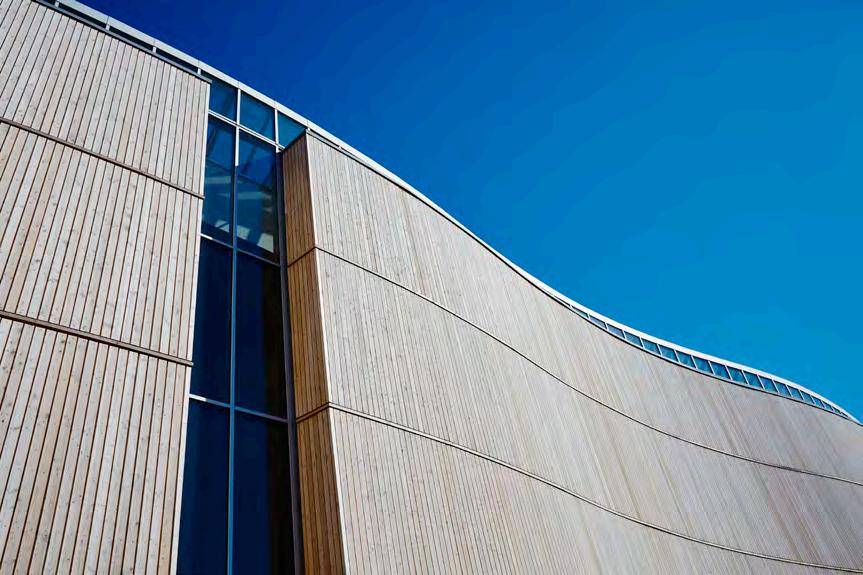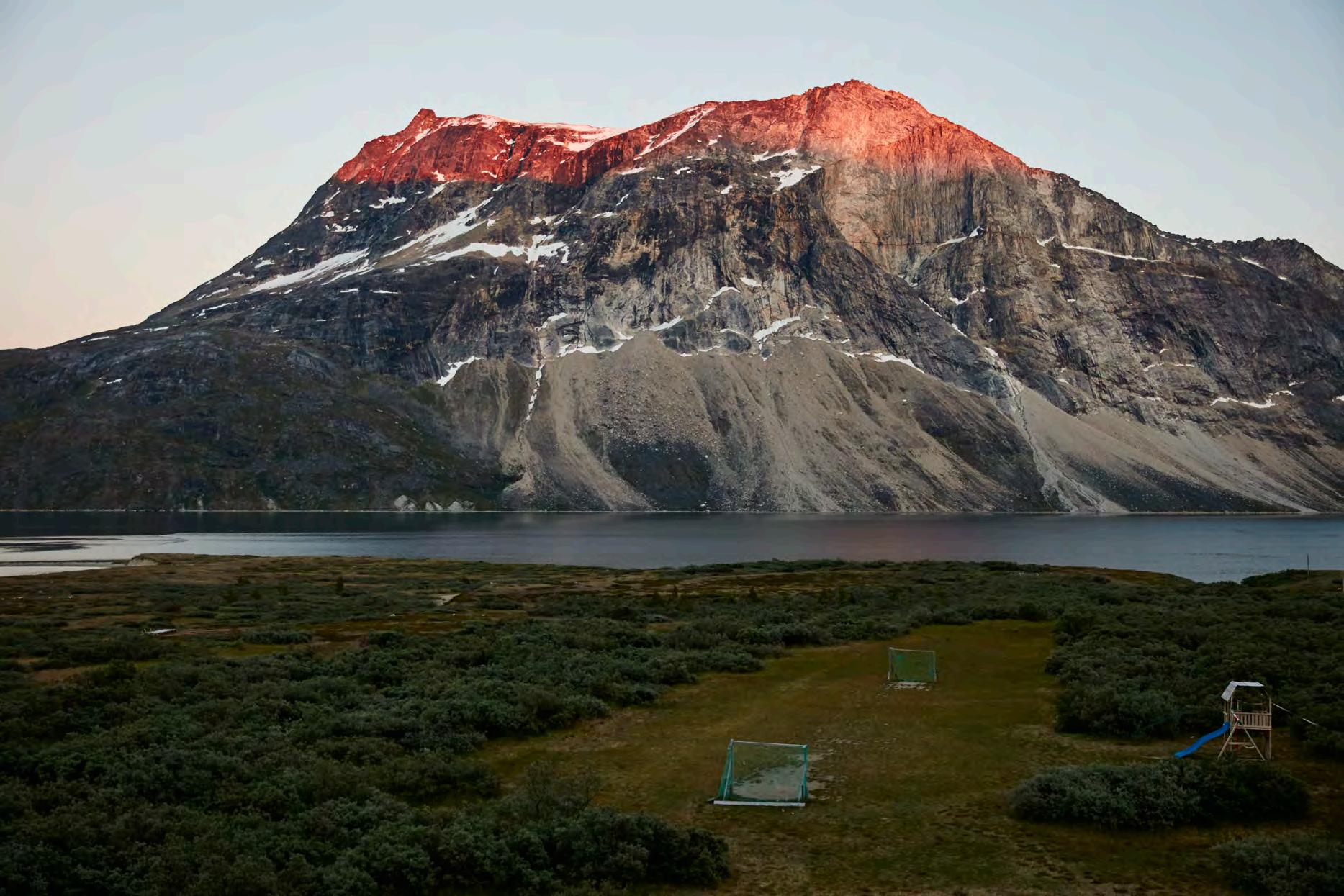
7 minute read
Discovering Nuuk Fjord
TRAVEL Greenland
Greenlandic summer
On the “great white”, the mercury can rise.
01
TEXT AND PHOTOS: Jonathan Pozniak
“They never believe us”, the woman in the cabin said. It’s been said for many years about Greenlandic summers: “The heat, the sun, the mosquitoes”, she droned. You may think we’re talking about Sub-Saharan Africa or an island in the Caribbean, but here on the “great white”, the mercury can rise.
I know what you’re thinking, dear readers. What kind of unequipped sissy can’t hack 21°C (70°F) degree heat? Hiking across vast rocky landscapes under 22 hours of blazing sun, covered head to toe to preserve your blood reserves, means you’re gonna sweat. The irony of this weather forecast aside, disbelievers have tried many times to greet these shores without a mosquito net, their confidence quickly sucked dry alongside their blood. The Greenland Air Force, aka Arctic mosquitoes, are a force to be reckoned with. But for centuries travellers have pioneered this island for the freedom. An expanse so boundless and remote, a few steps past your cabin and no one can see you and no one can hear you. Your participation in life matters only to the birds and fish. You feel small. Really small. In Greenland, nature is permanent but people are not. Places are named after how things look, because while humans come and go, the earth stays in place. People come here to feel how big nature is, and no matter how small you feel in her presence, Greenland will take you by the hand, lead you down her paths,
Greenlandic summer

up to her mountain peaks, and across her glaciers. If you listen closely and follow her lead with trust and respect, she’ll tell you her stories and sing you her songs.
Setting sail
From Nuuk we sailed for half a day, deep into the fjord aboard the M/S Sterna. Captain Erik Palo Jacobsen is a former merchant marine who’s sailed the seven seas, only to return home to Nuuk, his own personal paradise. He takes visitors to his favourite hidden spots, whether they have reindeer hunting in mind, deep sea fishing for redfish and cod, or a touch of gold fever. After sailing through a maze of crystal clear glacial meltwater and towering peaks, we arrive at Qooqqut Nuan, a settlement for people who want to enjoy being off the grid yet eat like a berserker. A collection of off-the-grid cabins and a main house with the fiercest kitchen in the north, “Nuuk Yorkers” and visitors alike come here as soon as the sea ice melts with their own local catch. The chefs are a mix of Danish, Greenlandic, and Thai. Whether you’ve cast your rod in the fjord or hunted reindeer on land, there’s only one rule: what you catch is what you eat. With meat and fish that fresh, cooked in some homemade Thai curry, the best of these two worlds collide into nirvana.
But a fancy boat and fishing reel isn’t the only way to catch dinner. In Qooqqut, experts teach you to catch fish
TRAVEL Greenland
02 03




04 05 01 Sunset at the top of the mountain at Qooqqut Nuan.
02 Icebergs in Nuuk Fjord.
03 Deep sea fishing for Redfish in Timmianguit near Qooqqut Nuan.
04 Feather from a white-tailed eagle, one of Qooqqut’s residents.
05 Small summer houses in Qooqqut.
with your bare hands. Pilo Samuelsen grew up in a small settlement just north of the Arctic Circle, learning many special skills like hand fishing the hard way – through practice and focus. “All hunting and catching requires your mind to stay present and focused, in a much different way than any academic skill will demand. It has the ability to shape your life and lifestyle. I guess you can’t grow up in a place like this without it having an effect on you”, he says of his life on the edge.
Back in the day
Qooqqut’s first settlers were the Vikings, and their footprints are still seen to this day. They built a stable for their cows and dug a well for drinking water, right in front of what is now the kitchen. Vikings throughout history marked their wealth by their cattle and went to great lengths to protect them. These thick stone walls are still standing on the property. Historians debate whether they were driven out of Greenland by the Inuit, or because of a mini ice age courtesy of an Indonesian volcanic eruption (Icelanders can certainly relate). But theories now shift as to why they settled there in the first place. Old school archaeologists as well as the Sagas have told us of their farms and settlements, but a new reason to conquer these rugged lands has emerged: walrus hunting. While the climate became too cold for cattle, and their diet shifted to the delicacies of fresh seal, another ocean creature became irresistibly alluring to these seafaring men. Ivory from walrus tusks was one of medieval Europe’s most valuable trade items, and as they were hunted to extinction in Iceland, the Vikings found them in abundance on the west coast of Greenland.
Rock (and roll)
Long before the first footprints on earth from humans, the geology of the fjord hasn’t changed in aeons. The oldest rock in the world, dated at 3.5 billion years young, sits perched enjoying the same view season after season, it’s deep blackness embracing the sun. The labyrinth of tall peaks and deep water has a diversity for those who’ve listened to its rhythms and stories over the years. The forces of nature in Greenland command great respect. Autumn
06 Captain Eric Palo Jacobsen of Arctic Boat Charter aboard the M/S Sterna.
07 “Mosquito Valley”, a historic neighbourhood in Nuuk, at sunset. Sermitsiaq mountain is in the background.
08 Taking photos of “Mosquito Valley” in the fog.
09 Greenlandic barbecue reindeer meat.
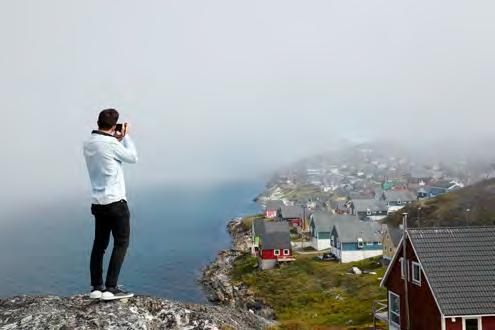

06 07
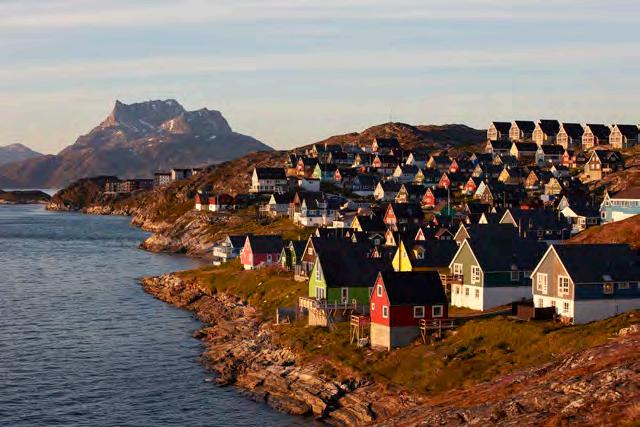
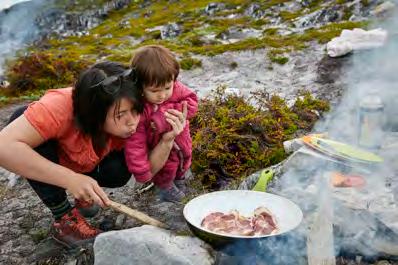
08 09
and winter can bring severe storms and darkness, while summer brings long days of a warm sun enjoying its freedom to stay up way past its bedtime. One small island is home to a shamanic grave, a site where shaman apprentices found their animal spirits. They would sit outside for days all winter, starving and cold, going deeper into a trance until – if they stayed alive – their spirits would find them. Another end of the fjord is home to Qoornoq, a former ghost town and abandoned fishing factory, brought back to life by Nuuk locals refurbishing brightly-hued houses into summer cabins.
No matter what season you visit, time seems to stand still in Greenland. Nature watches closely, infusing herself into every animal, every storm, and every trail humans have carved. On that summer night, once the sun set to a silver glow, the kitchen’s waiter and chef would break out their guitars. They sung Iggy Pop while fumbling over the chords, the lyrics of “The Passenger” emerging from a Danish/Thai accent duet. The bartender, a blonde Danish woman who was equal parts affable and sarcastic, would pour drinks for the boaters and tell stories of fjord characters. These aren’t the children seen on postcards in native dress and kamiks. They represent Greenland today, where Inuit, colonialists, and Vikings have all converged, and for these warm summer months coexist peacefully. There was no place for a language barrier or whose ethnicity mattered. It was just us, way out there in the fjord. It was us against the mosquitoes.
Getting there:
Nuuk
Reykjavik
Air Iceland Connect offers direct flights to Nuuk from Reykjavik Airport, thrice weekly May to October and twice weekly November to April. Arctic Boat Charter (ABC) and other companies offer tours in and around the Nuuk Fjord – deep sea fishing, gold panning, Norse and Inuit ruins and more – as well as to Qoornoq and Qooqqut Nuan. airicelandconnect.com visitgreenland.com









